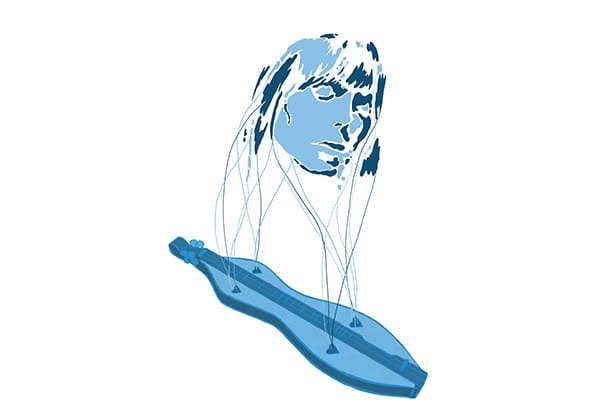Autumn was in full-swing in California. Temperatures were starting to drop around Big Sur’s ragged, windy coastline. Joellen Lapidus spent days upon days wandering through the nearby forest in search of inspiration. She was deep among the redwoods, where sparrows scampered about the dry crumpled leaves and babbling brooks met the River Gorge. It was only upon spotting the tiny teardrop shaped columbine flowers on the forest floor that she knew she’d struck gold.
Joellen Lapidus is a folk musician and artisan. She started making dulcimers after moving to Big Sur in the late ‘60s, inspired by the glimmering Atlantic, freewheeling locals and Jack Kerouac’s ‘big elbows of rising rock’. She’d buy giant slabs of walnut and spend her days sanding them down and cutting out the violin-shaped pieces. The Appalachian dulcimer is a type of folk zither. Three to five metal strings run across the narrow body of the instrument to produce a light, feathery tune. The plucked box-zither was traditionally constructed with whatever wood was found nearby: walnut, cherry, chestnut, or maple. For years the dulcimer’s origins were a mystery — there were few written historical records of the instrument. Whispers echoed from the peaks of the Appalachian mountains, from the top of the Canadian coast, way down to Alabama. Rumours circulated among folk circles that the instrument originated from Scottish-Irish immigrant communities. Yet there was no precedent for the dulcimer’s ‘slender symmetry’ and elaborately shaped sound-box.
It was 1969 and Lapidus was preparing for the Big Sur Music festival; she had her heart set on selling her idol Joni Mitchell her very first dulcimer. Crosby, Stills and Nash were headlining, Joan Baez would play the Dylan track ‘I Shall Be Released,’ and the whole two-day event would be memorialised in the documentary Celebration at Big Sur which would then go on to be released in 1971.
The day before the crowds descended, Joellen was putting the finishing touches on the Festival Dulcimer when fate stepped in. Joni met Joellen wandering the festival grounds when the dulcimer, decorated with red, wild columbines, caught her eye. The singer did away with the traditional quill and instead sat it across her knees, slapping the instrument; summoning rhythms that many players couldn’t evoke.
Mitchell took the Dulcimer across the Atlantic on her European pilgrimage. She abandoned the comfort of the Canyon for the streets of Crete. In those few months away, Joni wrote most of Blue on just the dulcimer and flute — packed for their versatility and compact size. The instrument formed the basis of the album that would cement her name in musical history.
The sharply plucked strings open the record.
I am on a lonely road and
I am traveling, traveling, traveling, traveling
‘Carey’ was constructed among Cretian caves in the Ionian tuning — about her companion, the local cook whose hair was almost as fiery as his disposition. ‘California’ was written in Paris and captures homesickness, as if The Golden State was her long lost lover. The instrument became the soundtrack to Joni’s life on the road, with equal measures of loneliness and adventure — just the artist and her five strings. Music writers for years have cited that the light strumming of strings balances the record, uplifting the vulnerability of Mitchell’s lyricism. It offers a vacation from the deep melancholy piano ballads like ‘River’ and ‘Blue.’
But that is not the first time the dulcimer rose to fame. Before Joni and Joellen’s fateful encounter, Brian Jones had whipped out an electric dulcimer on The Rolling Stones’ 1966 track ‘Lady Jane.’ Jones was as uncertain as anyone about the instrument’s origins. He claimed it was an old English instrument used at the beginning of the 20th century, an easy mistake to make, as many early British colonies claimed the instrument as their own.
Almost all European folk music had similar-sounding string instruments. There was the Norwegian Langeleik, the Swedish Hummel, and the French Epinette. And yet none quite rang like the dulcimer. Beech Mountain folklore claimed the instrument arrived with a travelling salesman from Bristol. Other stories, recorded by Lucy Long, explain that a “stranger from the West” who was lodging with a local farmer brought the dulcimer to the region.
The mid-1980s saw the mystery of the dulcimer finally solved. Joni’s European pilgrimage a decade earlier had inadvertently returned the instrument to its roots. Ralph Lee Smith and L. Alan Smith traced the instrument back to the Germanic folk traditions of northern Europe. The German scheitholt, a type of zither, had been prominent in communities in the Appalachian mountains throughout the late 18th century. The instrument evolved, as did the lives of those who played it. The slow, resonating strings couldn’t keep up with demands of dance music so they bumped up the volume and allowed for the faster playing techniques Mitchell would employ as she called for Carey to get out his cane.
It’s been half a century since Blue was released, and Mitchell’s contemporaries continue to scour America, chasing the same angelic strums born in the Canyon. In the lead up to his sophomore album Fine Line, Harry Styles tracked down Joellen. She still lives moments from the forest where she spotted the wild columbines for the festival dulcimer. The dulcimer is sweetly interspersed in the background of Styles’ track ‘Canyon Moon’ — his love letter to California and homage to Mitchell’s song.
Oh will you take me as I am,
Strung out on another man,
California I’m coming home.





